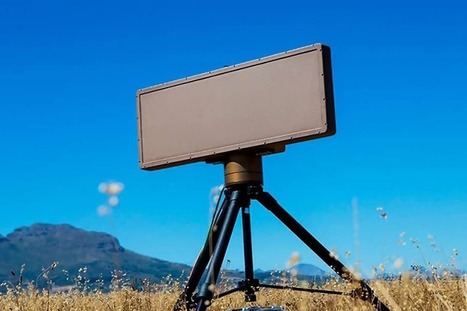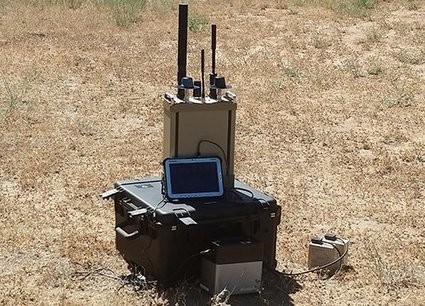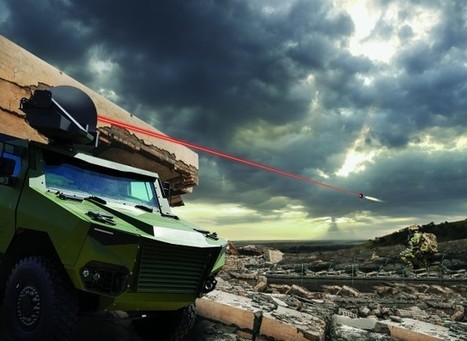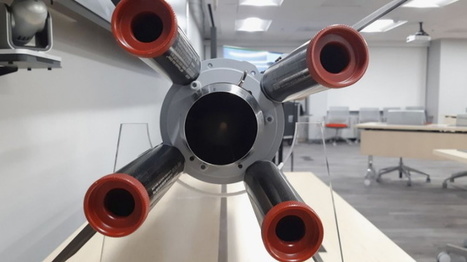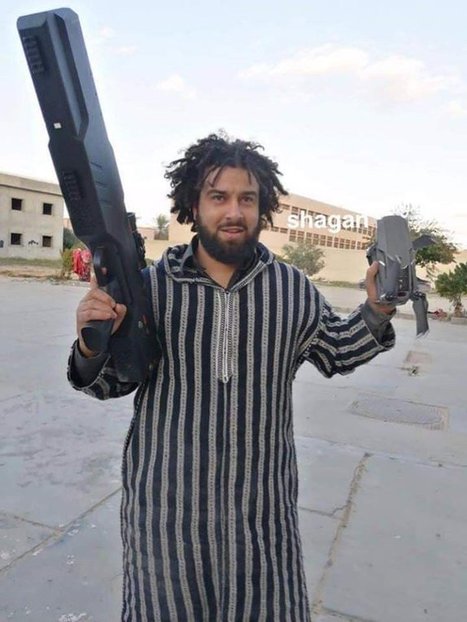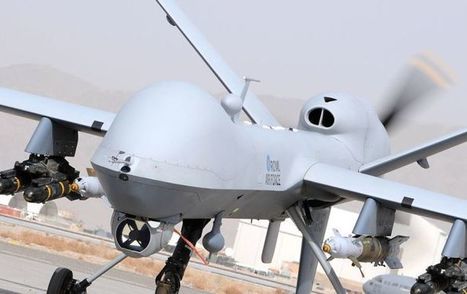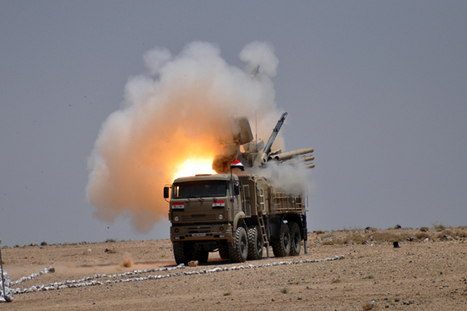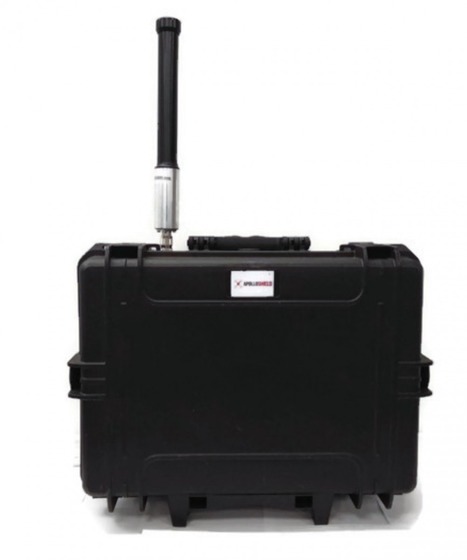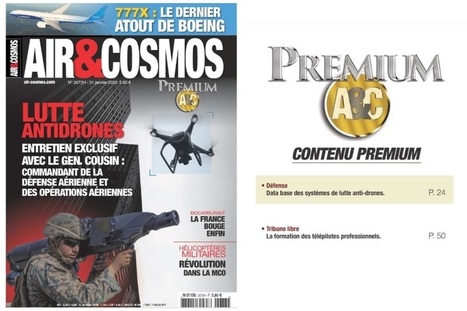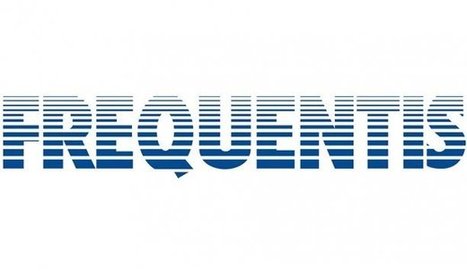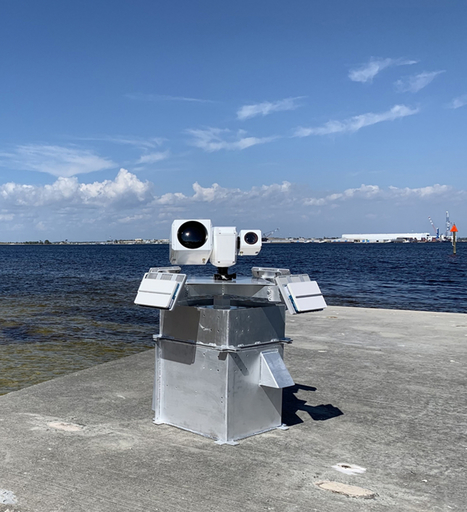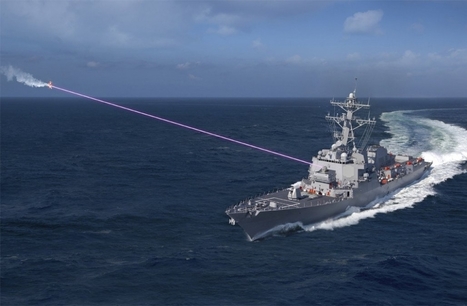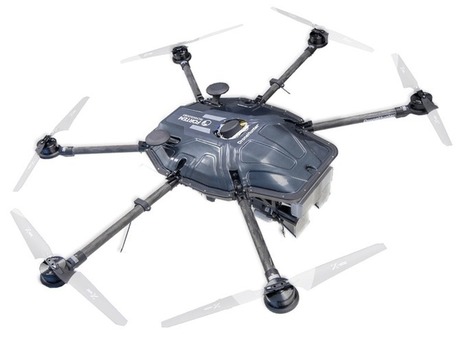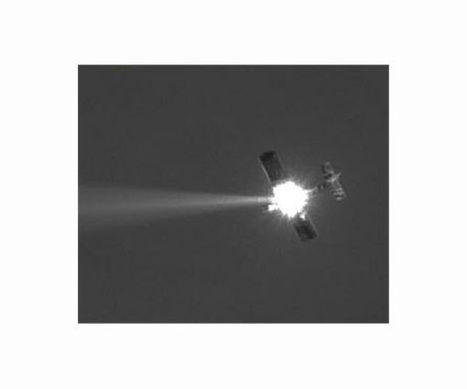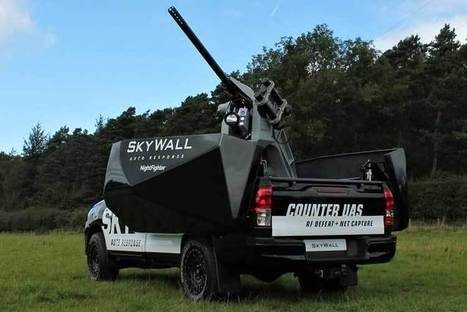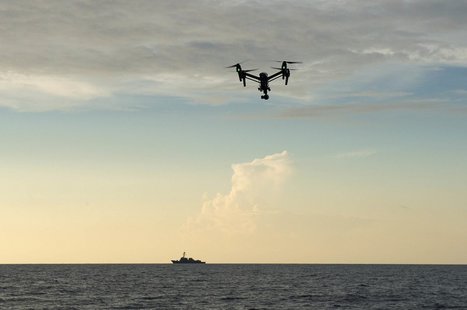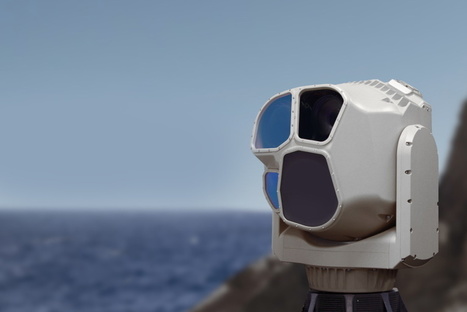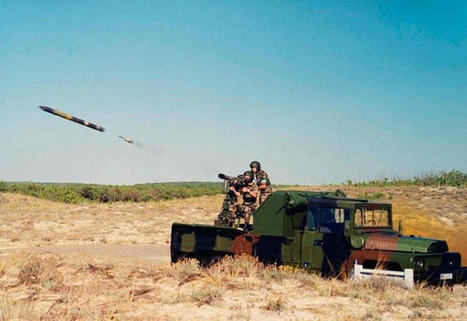 Your new post is loading...
 Your new post is loading...

|
Scooped by
Romain
March 15, 2020 3:01 PM
|
La société américaine Dynamite Global Strategies a dévoilé un nouveau radar, pouvant être mis en œuvre dans le cadre de la lutte anti-drones.
Développer les moyens de détection.
La lutte anti-drones comporte aujourd'hui un défi de taille au niveau de la détection. De nombreux radars ne sont pas adaptés à l'observation de petites cibles et ne parviennent pas toujours à détecter des drones de petite taille. Pour faire face à ces lacunes Dynamite Global Strategies a dévoilé un nouveau radar, le DSR-3X, adapté à la détection de drones de classes 1 et 2 (masse maximale au décollage de 5 kilos).
Renforcer la lutte anti-drones.
Le DSR-3X, qui appartient à la famille de produits DroneMaster, permet ainsi de détecter, suivre et classifier les cibles aériennes évoluant dans le périmètre surveillé. Ce radar 3D permet à la fois d'observer l'espace aérien à basse altitude et les mouvements au sol, afin de fournir une surveillance complète aux acteurs de la sécurité. Disposant d'une capacité de détection générale de 15 km, passant à 5 km pour les drones, ce radar scanne les zones surveillées à 360 degrés.
Des systèmes complets.
Afin de mettre au point le DSR-3X, DGS a capitalisé sur son expérience dans le domaine des radars et particulièrement de la famille DroneMaster. Dans le but de fournir une couverture complète et des capacités de lutte anti-drones sur l'ensemble de la chaîne, l'industriel préconise de coupler les radars à d'autres capteurs, tels que des caméras électro-optiques, ainsi qu'à des contre-mesures, permettant de neutraliser les drones. « En allant plus loin que la plupart des radars de surveillance au sol, notre nouveau radar DSR-3X peut à la fois surveiller l'espace aérien à basse altitude pour les drones, tout en surveillant simultanément le sol pour d'autres menaces. Cela signifie que le DSR-3X peut également suivre les opérateurs de drone », a déclaré Daniel Chou, PDG de DGS.

|
Scooped by
Romain
March 15, 2020 2:35 PM
|
En collaboration avec le CEPN (centre d'expertise des programmes navals), la Marine nationale a mené des essais de lutte anti-drones à la mer.
La Marine Nationale expérimente des solutions de lutte anti-drones.
Après l'Armée de l'air et l'Armée de terre, c'est désormais au tour de la marine nationale de se saisir du sujet de la lutte anti-drones. Et si la chose n'est déjà pas aisée sur terre, elle se complexifie encore davantage en mer. C'est dans ce contexte qu'ont eu lieu des expérimentations pendant le mois de février, à bord du chaland multi-missions (CMM) Grillon, sur la base navale de Toulon. « Pendant plusieurs heures, dans la grande rade de Toulon, le bâtiment a subi des raids répétés de microdrones. Les équipes ont pu s'entraîner à détecter, identifier et neutraliser ces micro aéronefs », précise le Ministère des Armées.
Evaluer le matériel.
Un entraînement qui a permis aux forces de se familiariser sur l'ensemble de la chaîne de lutte anti-drones, allant de la détection, souvent radars ou électro-optiques, à la neutralisation. Ces essais ont ainsi permis « d'identifier les capacités du matériel de détection, d'identification et de neutralisation mis à disposition du CEPN et d'évaluer les distances de détection électromagnétiques, acoustiques et optiques des microdrones aériens en zone côtière », détaille la Marine nationale. Des expérimentations qui sont avérées concluantes puisque l'ensemble des drones mis en œuvre autour du bâtiment ont pu être détectés. La moitié d'entre eux ont par ailleurs été neutralisés.
Se préparer face à l'évolution des menaces.
La conduite de cet entraînement dans un contexte maritime s'avère indispensable au regard du paysage des nouvelles menaces auxquelles les armées vont être confrontées. Les drones, souvent peu couteux, faciles à modifier et à mettre en œuvre, représentent une menace de plus en plus importante, comme l'a notamment démontrée l'opération Chammal. Même si pour le moment les bateaux ne sont pas les premières cibles des drones malveillants, pouvoir se prémunir contre des attaques ou actes d'espionnage fait partie des défis de la Marine nationale et plus généralement des armées.

|
Scooped by
Romain
March 5, 2020 2:47 AM
|
Malicious use of small drones continues to impact military, government, and commercial operations. After extensive testing, evaluation, and operational assessments from over two dozen customer groups, Citadel Defense has received $9.2 million in orders for its industry-proven C-UAS capabilities since the beginning of the year.
Citadel’s Titan C-UAS technology detects and defeats small unmanned aircraft system targets before they become a threat. Citadel Photo
Advertisement
Citadel’s Titan C-UAS technology will be used to protect high-value assets in urban, rural, and maritime environments. In austere and uncertain environments, operator’s trust Citadel’s autonomous, full-spectrum protection to accurately detect and defeat small unmanned aircraft system (sUAS) targets before they become a threat.
“Drones are an asymmetric threat that require unprecedented speed for innovation. Citadel’s AI-capabilities and responsiveness give customers a cost-effective option that addresses a very large portion of the sUAS threat,” said Christopher Williams, CEO of Citadel Defense. “Strong Warfighter references and combat-proven results over the last two years helped secure this order.”
As new drones are released to the market, Titan systems receive new software to address the new threats. If Titan’s AI algorithms do not detect the threat right away, the company explained that it can deliver an end-to-end capability in 72 hours for most drones and less than four weeks for the most complex drone signals. The use of AI, deepnets, and adaptive countermeasures provide Titan with scalable force protection that can address the needs of the small unit, a large base, or mobile vehicle.
Advertisement
“We prioritize safety, security, and a clear airspace above all else,” Williams said. “Our AI approach allows us to quickly address new threats without the risks or uncertainty that comes with hacking the drone link. Citadel is able to reliably keep customers ahead of the ever-evolving threat faster than other solutions in the market.”
The company’s Titan system is now being effectively integrated into layered solutions that combine radar, optics, and kinetic countermeasures to help customers detect, identify, track, defeat, and report on threat sUAS.

|
Scooped by
Romain
March 2, 2020 1:26 AM
|
Fusils à pompe, dispositifs de brouillage, radars et autres rapaces : l’armée française multiplie depuis longtemps les initiatives visant à lutter contre les drones. Et si la solution résidait finalement dans les armes laser ? Champion français des systèmes laser, CILAS se positionne désormais sur ce segment émergent avec un dispositif baptisé HELMA-P prochainement évalué par le ministère des Armées.
« Le caractère éminemment stratégique de CILAS montera encore en puissance avec l’émergence des armes laser. A court terme, ces armes laser ont déjà un rôle à jouer dans le domaine de la lutte anti-drone, » déclarait Florence Parly lors d’une visite récente sur le site de CILAS. Consacrée à 60% au marché de la défense, cette filiale d’ArianeGroup basée à Orléans emploie 260 salariés pour un chiffre d’affaires annuel de 47M€.
D’après CILAS, HELMA-P a pour objectif d’offrir une rupture technologique aux armées en proposant une arme anti-matériel discrète, précise, peu onéreuse, dépourvue de munitions et à effets gradués. Ce système est capable de suivre et de détruire un micro-drone dans un rayon d’un kilomètre pour un coût par tir de quelques centimes d’euro. Différents scénarios opérationnels sont envisagés, dont celui de la lutte anti-drone qui réunirait au sein d’un même système les fonctions de détection, de suivi, d’identification et de neutralisation de cibles. HELMA-P ne doit donc pas être confondu avec TALOS, programme préparatoire de l’agence européenne de défense (AED) coordonné depuis 2019 par CILAS et finançant le développement d’une arme laser anti-missile principalement axée vers la neutralisation de munitions ou de missiles sur trajectoire.
À ce jour, HELMA-P s’appuie autant sur des briques en cours de validation que sur des développements homologués par CILAS, plusieurs d’entre-eux étant commercialisés depuis plusieurs années. Entièrement conçu par la PME orléanaise et ArianeGroup, ce système comprend des fonctions comme le suivi vidéo des cibles, la sécurisation des tirs laser, la source laser proprement dite, un LIDAR, ainsi que les éléments de commande et de contrôle.
Les investissement consentis dans le développement des lasers de puissance auront notamment soutenu une montée en maturité des composants critiques, tels que les batteries et la fibre laser. « La technologie présentée aujourd’hui permet donc de répondre efficacement aux questions du refroidissement, de l’énergie et de la sécurité, » nous explique-t-on.
Une démonstration à l’automne 2020
Florence Parly l’avait annoncé en début de mois, un démonstrateur technologique du système HELMA-P sera évalué d’ici à l’automne prochain à Biscarosse (Landes) avec le soutien de l’Agence de l’innovation de défense (AID). Ces premiers essais de neutralisation seront réalisés sur base d’une version trépied du système. Celui-ci effectuera une série de tirs sur cibles fixes et mobiles avec plusieurs fonds de scène « afin de valider différents scénarios opérationnels ».
La suite ? Hormis le démonstrateur sur trépied, HELMA-P est conçu pour être intégré sur un véhicule terrestre mais aussi pour être couplé avec un système hôte, tels qu’un noyau C2 et un système de gestion du champ de bataille (BMS), afin de se rattacher aux principes du combat collaboratif élaborés par le programme Scorpion. Le volume interne nécessaire à l’alimentation du système est totalement compatible avec celui d’un VBMR Griffon, voire avec le futur Véhicule blindé d’aide à l’engagement (VBAE) attendu lors de la prochaine loi de programmation militaire. Une solution navalisée sera également proposée par CILAS pour contribuer à la protection des bâtiments militaires.
Selon CILAS, HELMA-P sera disponible sur le marché d’ici à la fin de l’année 2020. La France se place d’emblée pole position des clients potentiels avec un ministère des Armées qui s’est dit « prêt à se doter très vite de prototypes » par l’entremise de Florence Parly.

|
Scooped by
Romain
February 26, 2020 12:08 AM
|
The US Army has approved Raytheon's Coyote Block 2 counter-unmanned aerial system (C-UAS) for Foreign Military Sales (FMS).
Lisa Hunter, US Army spokesperson, said on 19 February that interested customers should submit a letter of request through their local security co-operation office, starting with the Office of Defense Cooperation at their local US embassy. The Coyote Block 2 C-UAS capability is a rail-launched surface-to-air missile (SAM) being developed for the US Army through the Defense Microelectronics Activity (DMEA).
Juan Santiago, C-UAS product director at the Program Executive Office (PEO) Missiles and Space, part of the US Army Rapid Capabilities Office, told Jane's on 12 February that this Coyote C-UAS contract is a cost-plus-fixed-fee effort that provides analysis, design, development, prototyping, integration, testing, and production of expendable tube-launched UAS to protect against hostile attacks, intelligence gathering, and other malicious activities directed against critical infrastructure.
Raytheon Missile Systems was awarded three tasks orders, all awarded competitively, as part of the Coyote Interceptor Program. Santiago said that the first contract was awarded through the Office of Naval Research (ONR) while the second contract was through the Defense Innovation Unit (DIU). The third competitive contract, he said, was awarded by the DMEA.
Pete Mangelsdorf, Raytheon Missile Systems programme director for Coyote and rapid development programmes, told Jane's on 23 January at a Raytheon facility outside Washington DC that the Coyote Block 2 C-UAS was powered by a commercial off-the-shelf (COTS) turbine engine that takes over from an initial rocket assist boost that gets the Coyote Block 2 C-UAS off the rail. Mangelsdorf said that the company reduced the cost-per-kill on each missile by 10% by using a COTS turbine engine instead of a proprietary engine.

|
Scooped by
Romain
February 24, 2020 2:25 AM
|
En pleine guerre des drones, une photo est apparue hier montrant un militiant du Wifak (GNA) dans le quartier Salah Eddine avec un fusil à ondes anti-drone chinois, Jiangsu Digital Eagle QR-07S3 et son trophée, un DJI Mavic Pro. Merci à Abraxas SPA pour la photo! Si la Libye vous intéresse, écoutez cette interview d

|
Scooped by
Romain
February 19, 2020 1:29 AM
|
Rafael has completed a demonstration of its Drone Dome C-UAS in which it intercepted several manoeuvring UAVs using its hard-kill laser beam director.
The C-UAS achieved a 100% success rate in all test scenarios.
The Drone Dome is fully operational and is already deployed around the world offering modular infrastructure with electronic jammers and sensors which can provide detection, full identification and neutralisation of UAV threats. It is in use for the protection of both military and high-risk civilian sites such as airports and border zones.
According to Rafael, the Drone Dome is unique in its capability to integrate laser technology with C4I functions to allow locking and hard-kill. This laser can be fitted to the ground station control vehicle.

|
Scooped by
Romain
February 13, 2020 1:53 AM
|
Développé par le groupe israélien Rafael, le système Drone Dome est capable de neutraliser tout un essaim de drones en les brûlant l’un après l’autre avec un puissant laser.

|
Scooped by
Romain
February 12, 2020 1:49 AM
|
TRD Singapore, a locally based developer specialising in the design and manufacture of counter-unmanned aircraft system (C-UAS) technology, has taken the opportunity at the Singapore Airshow 2020 to launch its new Orion H+ lightweight C-UAS jammer.
According to company specifications, the Orion H+ is a portable and IP65-rated ruggedised system that weighs less than 6 kg without its optional scope. It is powered by a hot swappable 22.2V 5000 mAh lithium polymer (Li-Po) battery that supports over 60 minutes of continuous operation or up to 48 hours of standby runtime.
Sam Ong, managing director of TRD Singapore, told Jane's that he believes the Orion H+ is the first of its type in the world to be capable of disrupting up to six radio frequency (RF) bands including the industrial, scientific, and medical (ISM) RF bands of 433 MHz, 915 MHz, 2.4 GHz, 5.8 GHz as well as other specified global navigation satellite system (GNSS) frequencies - such as Beidou, GLONASS, and GPS - at ranges of up to 1,000 m depending on the type of UAS being intercepted.
The Orion H+ offers an angle of coverage of between 30 and 35° directly ahead of the operator, and comprises up to six jammer modules that each offer a rated power output between 3-5 W. Each module can be individually triggered, although the system can also activate all six modules simultaneously.
"The coverage is effective against most widely used commercial and DIY [do-it-yourself] drones and even military class [UASs]," said Ong. "ORION-H+ is designed to disrupt the remote control, telemetry, video link and GNSS transmissions and [triggers] their automatic landing or return home protocols in less than 20 seconds."

|
Scooped by
Romain
February 10, 2020 1:05 AM
|
L'entreprise française Cerbair annonce une nouvelle levée de fonds, qui devrait lui permettre de poursuivre son développement, dans un contexte favorable aux technologies de lutte anti-drones.
Cerbair, spécialisée dans les solutions de lutte anti-drones, annonce avoir réalisé une levée de fonds de 5,5 M€. De quoi bien commencer l'année 2020 pour l'entreprise qui a connu une croissance fulgurante en 2019. Cette levée de fonds a notamment été permise par la participation de Boundary Holding, Aubé Management, Smart Move Holding, ainsi que des partenaires historiques que sont MBDA et TF Participations.
Grâce à cette levée de fonds, Cerbair souhaite ainsi pouvoir « accélérer son développement commercial, industrialiser sa solution portable embarquée dans un sac à dos et intégrer de nouvelles briques technologiques à sa solution ». En effet, outre la capacité à pouvoir intégrer sa solution de détection des radiofréquences et de neutralisation sur différentes plateformes, Cerbair adopte une approche modulaire, afin de pouvoir répondre à l'ensemble des besoins du marché, aussi bien civils que militaires.
Ainsi, en 2019, les solutions de Cerbair ont été déployées au cours du festival d'été de Québec, afin de protéger l'ensemble de l'événement contre l'intrusion de drones. Ce festival, qui attire jusqu'à 100 000 fans quotidiennement, dispose d'un public international. « Souvent ces touristes ne connaissent pas les lois canadiennes interdisant les vols de drones au-dessus des foules. Ces dernières années, plusieurs des contrevenants étaient en effet des touristes provenant de l'extérieur du pays », rapporte ainsi le fondateur de Drone Vision International, fournisseur de solutions d'observation mobile par caméra et désormais en charge de la sécurité de l'événement sur la brique drones. Cependant, en raison de la popularité des artistes présents sur le festival et des menaces pouvant être posées par les drones, beaucoup exigent désormais la mise en place d'un protocole spécifique aux drones, afin de garantir leur sécurité.
C'est ainsi, après avoir travaillé avec une autre société, que Drone Vision International s'est tournée en 2018 vers Cerbair. « Nous avons décelé chez Cerbair un plus grand intérêt à vouloir collaborer avec des ''intégrateurs'' de systèmes comme Drone Vision International se définit ». Le système de détection des radiofréquences de l'industriel français a ainsi été sélectionné et intégré au sein d'un ensemble plus large, s'articulant autour d'un ensemble de solutions de surveillance. « Lors de l'événement Festival d'été de Québec, où nous étions en mission de détection de drones en soirée, le système Cerbair a bien détecté un vol à l'endroit où plus de 100 000 fans bourdonnaient, aux alentours de la scène principale. Nous avons détecté tout d'abord la mise en marche de la manette de contrôle par le pilote. Notre manque d'expérience en la matière nous a fait douter pour quelques secondes, peut-être qu'il s'agissait d'un faux positif qui peut, lors de ce type d'événement, être une source d'erreurs assez commune compte tenu du nombre de radiofréquences qui s'entrecroisent. Lors du décollage du drone le système de détection a donné une deuxième alerte. Immédiatement nous avons déclaré l'intrusion aux services de sécurité du FEQ. Ils ont pu localiser le pilote qui avait perdu le contrôle de son engin, percutant une colonne de son juste à côté de la scène. Le pilote a été appréhendé », témoigne ainsi Jac St Hilaire, président fondateur de Drone Vision International.

|
Scooped by
Romain
February 7, 2020 12:38 AM
|
Le Pantsir-S, qui est engagé sur plusieurs théatres d’opérations dans le monde mais essentiellement dans la région MENA, a abattu plus de 100 drones ces dernières années. C’est qu’a affirmé Valery Slugin, chef concepteur chez KBP Instrument Design Bureau, à l’agence de presse russe TASS.
« Une centaine, peut être plus. Cela prend en compte la Syrie et d’autres régions » a-t-il affirmé, en ajoutant que ce nombre était plus important en Syrie.
Slugin ajoute qu’à sa conception, le Pantsir prenait en charge les drones, qui à l’époque étaient plutôt grands et rapides avec des comportements similaires à ceux des avions. Depuis, le drone a changé, il est devenu beaucoup plus petit, avec une empreinte radar plus réduite et bougent très lentement ce qui est un cauchemar pour les systèmes anti aériens qui ont du mal à détecter les petits systèmes sans pilotes qui volent bas et lentement et qui se confondent avec les radiations du sol. Malgré cela, le Pantsir, selon Slugin, gèrerait bien ces difficultés.
Pour cela, une adaptation du radar du Pantsir a été faite pour la détection et la prédiction des trajectoires des objectifs furtifs et avec le nouveau missile sans tête chercheuse, il suffit d’envoyer le missile se faire exploser sur la trajectoire de l’objectif pour garantir qu’il soit touché par les débris.

|
Scooped by
Romain
February 6, 2020 1:38 AM
|
ApolloShield a complété son offre anti-drones avec le système Sense&Block, permettant de détecter et neutraliser les drones intrus.
Conscient qu'aucune solution miracle n'existe pour lutter contre les drones en raison de la diversité des cadres d'emploi, les entreprises impliquées sur le segment de la lutte anti-drones diversifient leurs offres afin de répondre à de larges besoins. Afin de mettre au point le système Sense&Block, ApolloShield a procédé auparavant à une analyse du marché. Ainsi, l'entreprise identifie deux grandes familles de systèmes.
D'une part on retrouve les traditionnels systèmes militaires de défense aérienne, au sein desquels une brique anti-drones peut être ajoutée, notamment au niveau de la détection radar. Ces systèmes s'avèrent très couteux et sont uniquement destinés à des acteurs militaires. Par ailleurs, les radars n'étant pas spécifiquement configurés pour la lutte anti-drones, la plupart présentent un taux de fausses alertes assez élevé. Cela demande également de disposer de personnels capables de gérer ces systèmes complexes et d'analyser la situation aérienne afin de discriminer par la suite les drones des oiseaux.
D'autre part on retrouve les fusils brouilleurs. Des systèmes de neutralisation qui s'avèrent largement efficaces et qui présentent un bon rapport qualité/prix. Bloquant les radiofréquences, soit le protocole de communication entre le drone et la télécommande, les fusils brouilleurs permettent d'immobiliser l'aéronef. Seule problématique de cette technologie, elle nécessite d'être couplée à un système de détection. Celle-ci se fait souvent par l'opérateur, à vue. Une contrainte qui limite ainsi la portée de la détection, d'autant plus en environnement urbain. De plus, afin d'établir une bulle de protection au-dessus d'un site, il apparaît dès lors nécessaire de positionner plusieurs opérateurs de fusils.
Afin de faire face aux différents défis posés par ces deux types de systèmes, ApolloShield a mis au point une solution tout-en-un, dénommée Sense&Block. Celle-ci permet ainsi de détecter la présence d'aéronefs et de déclencher de façon automatique le brouillage des radiofréquences. Il n'est dès lors plus nécessaire de faire intervenir un opérateur, la contre-mesure est déclenchée à partir de la détection. L'ensemble est contenu au-sein d'une boîte, laquelle peut être installée sur n'importe quelle zone ou plateforme. En effet ApolloShield met en avant le fait que le boitier Sense&Block peut par exemple être emporté sur un bateau ou bien au sein d'un véhicule pour protéger un convoi. L'antenne est alors installée sur le toit afin de pouvoir détecter l'approche de drones.

|
Scooped by
Romain
February 2, 2020 11:56 PM
|
Dans son dossier "Lutte antidrones", Air&Cosmos PREMIUM révèle cette semaine la liste des systèmes antidrones disponibles dans le monde.
Au sommaire d'Air&Cosmos magazine PREMIUM 2673H :
Dossier spécial "Lutte antidrones" de Justine Boquet :
Interview du général Vincent Cousin, commandant de la défense aérienne et des opérations aériennes
Antidrones : une industrie dynamique
Antidrones : coup de boost pour CerbAir
Neutralisation : MC2 Technologies se spécialise dans les fusils brouilleurs
Entretien avec le Raid : anticiper la menace pour mieux s'adapter
Etats-Unis : une équipe dédiée à la lutte anti-drones
Liteye livre des systèmes antidrones au gouvernement américain
Protéger les aéroports
Database complète : tous les systèmes antidrones disponibles dans le monde : exclusivité Air&Cosmos PREMIUM
Tribune : "La formation des télépilotes professionnels" par Jim Sharples et Cassandra Rotily : exclusivité Air&Cosmos PREMIUM
|

|
Scooped by
Romain
March 15, 2020 2:57 PM
|
Frequentis and Hensoldt have signed a memorandum of understanding (MoU) to intensify collaboration on integrated counter drone solutions for airports.
Frequentis, the leading air traffic management (ATM) solution provider, and defence and security sensor specialist Hensoldt are combing strengths to support the creation of next generation integrated counter unmanned aerial vehicle (UAV) solutions. Both companies are already combining their respective strengths and competences on the FALKE research project, which aims to develop the blueprint solution for the airport environment.
Advertisement
“The formation of this MoU further reinforces our intention to create effective solutions to differentiate cooperative and non-cooperative flying objects, ensure shared situational awareness across all organizations and interoperability with existing airport surveillance infrastructures and available UAV traffic management (UTM) systems. We are pleased to be working on this common goal with Hensoldt, combining our strengths.” says Günter Graf, Frequentis head of business development.
The Frequentis Group is providing mature components in the areas of UTM/ATM/drone detection, data fusion and exchange (MosaiX SWIM), shared situational awareness and ATM-grade surveillance data automation (SDDS-NG, MSDF, PRISMA), cross-agency incident management (ICM), as well as operational requirement analysis (Control Room Consulting). Hensoldt will provide detection, identification and mitigation modules from their own Xpeller CUAV system.
“Together with Frequentis, we will create a modular counter-UAV system optimised for the specific needs of airports”, added Markus Wolf, head of sales and business development at Hensoldt Ventures. “Xpeller demonstrates Hensoldt’s innovative capabilities, answering our customer’s needs to detect and act against unmanned threats. Due to its versatility, Xpeller is able to offer maximum protection under a variety of conditions and ranges. While available as a fully functional stand-alone system, its modular approach enables us to easily join forces with partners like Frequentis.”
Both companies already work together on the FALKE project, developing the ability to intercept small UAV that enter restricted airspaces at airports. The integrated solution will enable airports to deal with incidents, like those that took place at British airport Gatwick and German airport Frankfurt, swiftly and effectively. Hamburg Airport will be the model for the resulting blue-print solution, with the partners demonstrating a technical and organisational concept to defend against illegally operating drones.
Advertisement
In addition to Frequentis and Hensoldt, the FALKE project consortium includes the German Federal Police, German Air Traffic Control (DFS), Lufthansa, Hamburg Airport, and the chair of electrical measurement of the Helmut Schmidt University (HSU) in Hamburg. The project has begun with the creation of a demonstrator system, constructed with the integration of both, Frequentis and Hensoldt systems. In addition, both companies jointly support the EUROCAE Working Group 115 for Counter UAS. WG-115 was established to develop standards to support the safe and harmonized implementation of Counter-UAS Systems into airport and ANSP systems.

|
Scooped by
Romain
March 15, 2020 2:34 PM
|
Les scientifiques du Naval Surface Warfare Center ont mis au point une technologie permettant la détection de drones en mer.
Parvenir à détecter des petites cibles.
La division de Panama City du Naval Surface Warfare Center est parvenue à développer un système de lutte anti-drones, permettant de détecter, suivre et classifier des drones. Une technologie qui a été mise au point afin de pouvoir être employée en environnement maritime mais qui pourrait également être déployée sur terre. Le Naval Surface Warfare Center a principalement joué un rôle d'intégrateur et de connexion des différentes briques technologies.
Multiplier les moyens de détection.
Pour cela, le système Threat Tracker s'articule autour d'un radar 3D acheté sur étagère et des capteurs optiques. Mais afin de pouvoir identifier le drone et ne pas seulement détecter la présence d'un objet dans l'espace aérien, des algorithmes d'intelligence artificielle ont été intégrés dans le système. Grâce à l'analyse des images et des données collectées par les capteurs, et en les comparant avec les informations enregistrées dans la base de données, le système peut ainsi déterminer si la cible détectée s'agit bel et bien d'un drone. Un système permettant donc de faire de la discrimination entre drone et oiseau et ainsi de réduire le taux de fausses alertes.
Commander et contrôler
L'information complète est ensuite renvoyée vers un C2, qui sera chargé de décider des mesures à prendre en fonction du type de menaces. Afin de valider les propriétés du système, le Threat Tracker a été déployé au sein d'un exercice de la Navy. De nouvelles expérimentations devraient être conduites au cours des prochains mois, période pendant laquelle le système sera amélioré à partir des RETEX des opérateurs.

|
Scooped by
Romain
March 2, 2020 7:39 AM
|
Ce lundi 2 mars, dans sa chronique La France qui bouge, Justine Vassogne parle de l'entreprise CerbAir, qui a développé un système de lutte anti-drones en brouillant la communication entre l'appareil et son pilote dans l'Essonne. Cette chronique est à voir ou écouter du lundi au jeudi dans Good Morning Business présentée par Christophe Jakubyszyn sur BFM Business.
Dans "Good morning business", Christophe Jakubyszyn, Faïza Garel-Younsi et les journalistes de BFM Business (Nicolas Doze, Hedwige Chevrillon, Jean-Marc Daniel, Anthony Morel...) décryptent et analysent l'actualité économique, financière et internationale. Entrepreneurs, grands patrons, économistes et autres acteurs du monde du business... Ne ratez pas les interviews de la seule matinale économique de France, en télé et en radio.
BFM Business est la 1ère chaîne française d'information économique et financière en continu, avec des interviews exclusives de patrons, d'entrepreneurs, de politiques, d'experts et d'économistes afin de couvrir l'ensemble de l'actualité française et internationale. BFM Business vous propose aussi des conseils pour vos finances par des personnalités de référence dans les domaines du patrimoine, de l'immobilier ou des marchés financiers. Retrouvez tous les jours : Christophe Jakubyszyn, Faïza Garel-Younsi, Nicolas Doze, Hedwige Chevrillon, Jean-Marc Daniel, Anthony Morel, Guillaume Sommerer, Cédric Decoeur, Karine Vergniol, Grégoire Favet, Sébastien Couasnon, Emmanuel Lechypre, Benaouda Abdeddaïm, Stéphanie Coleau... BFM Business est disponible sur votre box (SFR : canal 46 / Orange : canal 228 / Bouygues : canal 242 / Canal : canal 108) ainsi qu'en direct et replay sur l'application BFM Business et le site : www.bfmbusiness.fr.

|
Scooped by
Romain
February 26, 2020 8:09 AM
|
The U.S. Navy recently installed the first Optical Dazzling Interdictor, Navy (ODIN), a laser weapon system that allows a ship to counter unmanned aerial systems. The first system was installed on the Arleigh Burke-class guided missile destroyer USS Dewey (DDG 105), during her recently completed Dry-Docking Selected Restricted Availability.
ODIN’s development, testing and production was done by Navy subject matter experts at Naval Surface Warfare Center (NSWC) Dahlgren Division in support of Program Executive Office Integrated Warfare Systems. Their work on the laser weapon system known as LaWS, positioned them to be designated as the design and production agent for ODIN.
During his recent visit on USS Dewey, Mr. James F. Geurts, assistant secretary of the Navy for research development and acquisition (ASN (RDA)) was impressed with the rapid progress made by the team. Geurts stated,
“This is a great example of our organic talent at the warfare centers all working together with ship’s company to deliver a system which will provide game-changing capability. Bravo Zulu to the entire ODIN team on being mission-focused and delivering lethal capability to the warfighter.”
Going from an approved idea to installation in two and a half years, ODIN’s install on Dewey will be the first operational employment of the stand-alone system that functions as a dazzler. The system allows the Navy to rapidly deploy an important, new capability to the Navy’s surface force in combating Unmanned Aircraft Systems (UAS) threats.
UAS production and employment has increased significantly, and ODIN was developed to counter these threats.
“The Pacific Fleet Commander identified this urgent Counter-Intelligence, Surveillance, and Reconnaissance need and the Chief of Naval Operations directed us to fill it as quickly as possible,” said Cmdr. David Wolfe, Program Executive Office Integrated Warfare Systems Directed Energy office. “The NSWC Dahlgren Division team did an amazing job addressing challenges and keeping our accelerated schedule on track and moving forward to deliver this capability.”
Within the next couple of years, the ODIN program will have all units operational within the fleet providing a safer and more technically advanced capability to the US Navy. Lessons learned from ODIN’s installation on Dewey will inform installation on future vessels and further development and implementation of Surface Navy Laser Weapon Systems.
Source: Press Release

|
Scooped by
Romain
February 25, 2020 12:09 AM
|
Le département à la défense américain a notifié à Fortem Technologies un contrat visant à fournir aux armées des solutions de lutte anti-drones.
Fortem Technologies a annoncé avoir remporté un contrat avec le département à la défense (DoD) américain, passé à travers la Defense Innovation Unit. Avec cet accord, Fortem Technologies fournira des solutions de lutte anti-drones à la défense américaine. Plusieurs systèmes ont été commandés, bien que leur nombre et montant n'aient pas été révélés. Le DoD a ainsi décidé de se doter des solutions SkyDome, DroneHunter, DroneHangar et du radar TrueView. L'emploi qui sera fait de ces systèmes n'a pas été spécifié, de même que les unités qui seront équipées.
Modularité.
Fortem Technologies ajoute par ailleurs que l'ensemble des solutions commandées par le DoD sont conçues en architecture ouverte, leur permettant d'être intégrées dans un système plus large et de communiquer avec d'autres technologies de lutte anti-drones. C'est ainsi également qu'il est possible de combiner les solutions Fortem Technologies afin d'adapter le niveau de protection aux infrastructures. D'une part, TrueView est un radar capable de détecter de petites cibles. Les données collectées à partir de différents capteurs peuvent être fusionnées et interprétées à l'aide du système d'intelligence artificielle SkyDome. Il est ainsi possible de détecter les menaces pesant sur l'espace protégé et d'émettre des alarmes lorsque cela est nécessaire. Dès lors, en guise de contre-mesures, il est possible d'avoir recours au DroneHunter, un drone intercepteur permettant de neutraliser les drones malveillants. Celui-ci communique avec le radar TrueView afin de pouvoir se diriger vers le drone identifié. Il lancera alors un filet afin de stopper sa progression.

|
Scooped by
Romain
February 21, 2020 2:27 AM
|
The U.S. Navy announced Thursday that it has installed a laser weapon system that allows ships to counter aerial drones.
According to the Navy, the first Optical Dazzling Interdictor, Navy (ODIN) was installed on the Arleigh Burke-class guided missile destroyer USS Dewey during the vessel's recently completed dry-docking restricted availbility.
The system's development, testing and production was carried out by Navy experts at Naval Surface Warfare Center Dahlgren Division.
"This is a great example of our organic talent at the warfare centers all working together with ship's company to deliver a system which will provide game-changing capability. Bravo Zulu to the entire ODIN team on being mission-focused and delivering lethal capability to the warfighter," said assistant secretary for the Navy for research development and acquisition after a recent visit on the Dewey.
According to the Navy, the install marks the first operational deployment of the system, which functions as a dazzler -- a non-lethal weapon that uses intense directed radiation to temporarily disable its target -- and allows the Navy to rapidly combat unmanned aerial threats.
"The Pacific Fleet Commander identified this urgent Counter-Intelligence, Surveillance, and Reconnaissance need and the Chief of Naval Operations directed us to fill it as quickly as possible," said Cmdr. David Wolfe, Program Executive Office Integrated Warfare Systems Directed Energy office. "The NSWC Dahlgren Division team did an amazing job addressing challenges and keeping our accelerated schedule on track and moving forward to deliver this capability.

|
Scooped by
Romain
February 18, 2020 2:00 AM
|
Inertial Labs, a developer of advanced inertial sensing technologies, has released a case study outlining how the company’s Dual Antenna Inertial Navigation System (INS-DL) has been used to provide precision location and orientation for OpenWorks Engineering’s SkyWall Auto Response counter-UAS (unmanned aerial system) solution.
SkyWall Auto Response is a mobile counter-drone system that uses sophisticated artificial intelligence (AI) techniques to identify and track rogue UAS within a restricted airspace, and launches a projectile containing a net and parachute to capture the drone and bring it safely down to the ground.
SkyWall Auto Response can be integrated with an external detection system (such as radar) to provide an end-to-end solution. The detection system cues SkyWall to the approximate direction of the drone using GPS coordinates. Inertial Labs’ INS-DL provides the system with orientation and position data in response to this GPS data that allow the SkyWall vehicle to operate even under highly dynamic conditions.
To find out more about Inertial Labs’ Dual Antenna Inertial Navigation System and its use in enabling high-precision counter-UAS applications, download the full case study here.

|
Scooped by
Romain
February 13, 2020 1:38 AM
|
Rafael Advanced Defense Systems has conducted the first live demonstrations of its Drone Dome-L counter-unmanned aircraft systems (CUAS) system using an integrated hard-kill high energy laser effector.
The Rafael-sponsored demonstration, conducted in southern Israel in December 2019 but only disclosed by the company on 11 February, provided for end-to-end detection, tracking, and laser interception of "multiple UAS, including manoeuvring targets" by Drone Dome-L's laser capability. The event was preceded by a two-year internal test campaign, which, in the past six months, has brought the Drone Dome-L system to a sufficient level of maturity to enable Rafael to stage the multiple intercept demonstration.
Rafael used Phantom-class quadcopter UAS systems as the threat targets in the demonstration; engagement ranges and specific laser dwell time required to defeat the threat was not disclosed.
Drone Dome-L is an end-to-end modular all-weather 360° system designed to offer protection against hostile micro- and mini- and micro UAS threats. The baseline Drone Dome-L configuration system comprises a RADA RPS-42 S-band multi-mission hemispheric radar, a long-range surveillance system (SPEED ER) developed by Controp, a communications package, and the C-Guard RD (rapid deployment) lightweight, fully programmable, portable jammer and NetSense Wideband detection sensor systems developed by Netline, all supported by advanced algorithms developed by Rafael. The company added the hard-kill laser beam director capability in mid-2017. The system can interface with various external systems and also supports future growth options, which includes additional sensors and effectors.
The RPS-42 is a four-panel (non-rotating) tactical air surveillance system delivering 360° coverage in azimuth and 90° in elevation. Optimised to detect, track, and classify all classes of UAS, the RPS-42 active electronically scanned array (AESA) software-defined radar has a detection radius of 30 km - including the detection of a minimum target size of 0.002 m² at a range of 3.2 km - and at altitudes from 30-30,000 ft.

|
Scooped by
Romain
February 11, 2020 1:38 AM
|
The UK Royal Navy could add a counter-UAS (C-UAS) capability to its vessels as the MoD looks to find a way to defeat the potential threat posed by sm

|
Scooped by
Romain
February 8, 2020 5:07 AM
|
CerbAir, a French defense, and security company that was launched in 2015, has secured €5.5 million in funding recently. Back in December 2017, CerbAir secured €1.5 million in a funding round with the help of several investors include Denis Gardin from MBDA, Jean-Michel Aulas, with his family office HOLNEST and Technofounders, the French accelerator that kick-started CerbAir.
With an estimated 10 million consumer drones in circulation today, the market is expected to rise to over 50 million by 2025. More than just a toy, these off-the-shelf UAVs (Unmanned Aerial Vehicles) are now being used for more sinister actions.
As per the company claims, drones are easy to purchase over the counter at affordable prices, and the threat is becoming ever more present.
However, CerbAir, with its state-of-the-art radio-frequency technology embedded in mobile or fixed anti-drone solutions, civilian drone threats can be detected from far away (up to 5km/3 miles).
Once detected and characterized, counter-measures can immediately neutralize the drone by forcing it to land through a mix of advanced jamming and hacking technology.
The company successfully commercialized its Anti-Drone Solutions at the beginning of 2017, notably within special forces worldwide, Prisons, VIP Villas, or Security Companies.
Lucas Le Bell, CEO of CerbAir:
The aim of CerbAir is to become the go-to anti-drone solution in this ever-evolving industry. Our tailor-made toolbox approach means that we can deliver cost-effective solutions that adapt to all client needs. One of our main selling points is our capacity to detect and pin down a drone before it even takes-off, even from several miles away. We couldn’t be happier with today’s funding round. We will enhance our offer with more features – ever more innovative ones –, boost commercial development while we stay in touch with the needs expressed in the field.

|
Scooped by
Romain
February 6, 2020 11:56 PM
|
Ascent Vision Technologies (AVT), a developer of gyro-stabilized imaging systems for aerospace and defense applications, has announced the launch of its next-generation multi-mission imaging system for maritime counter-unmanned aerial system (CUAS) and intelligence, surveillance and reconnaissance (ISR) missions.
The CM262M combines full HD, 4 sensor configurations and a next generation video processor in a compact, man-portable system, and is IP67-rated for high reliability in harsh maritime conditions. It can be integrated into AVT’s X-MADIS (eXpeditionary Mobile Air Defense Integrated System) anti-drone platform for improved detection, identification and tracking capabilities. The imaging system provides automated slew to cue on a detected object, allowing rapid interpretation and positive identification of flying objects – a critical component of any CUAS operation.
Lee Dingman, AVT President, commented: “A superior optic is a vital component of an effective counter UAS system as it provides necessary information on the characteristics of the sUAS to the operator, allowing for positive identification. Once correctly identified, the appropriate action can be taken against the airborne system.”
“The X-MADIS is already an extremely capable and innovative CUAS solution. The addition of the CM262M as the optics system allows us to further enhance the capabilities of the X-MADIS, particularly for maritime counter UAS missions.”
The CM262M will be showcased at the 2020 Singapore Airshow by AVT Australia, Ascent Vision’s APAC division.

|
Scooped by
Romain
February 3, 2020 12:20 AM
|
Actuellement, la lutte anti-drone relève essentiellement de l’armée de l’Air, grâce aux systèmes BOREADES acquis dans le cadre du programme MILAD [Moyens Mobiles de Lutte Anti-Drones].
Cependant, le 2 décembre dernier, la Section technique de l’armée de Terre [STAT] a évalué les systèmes anti-drones SkyWall100 et SkyWall Auto [fournis par OpenWorks Engineering et intégrés au système BOREADES de CS Group].
|




 Your new post is loading...
Your new post is loading...
